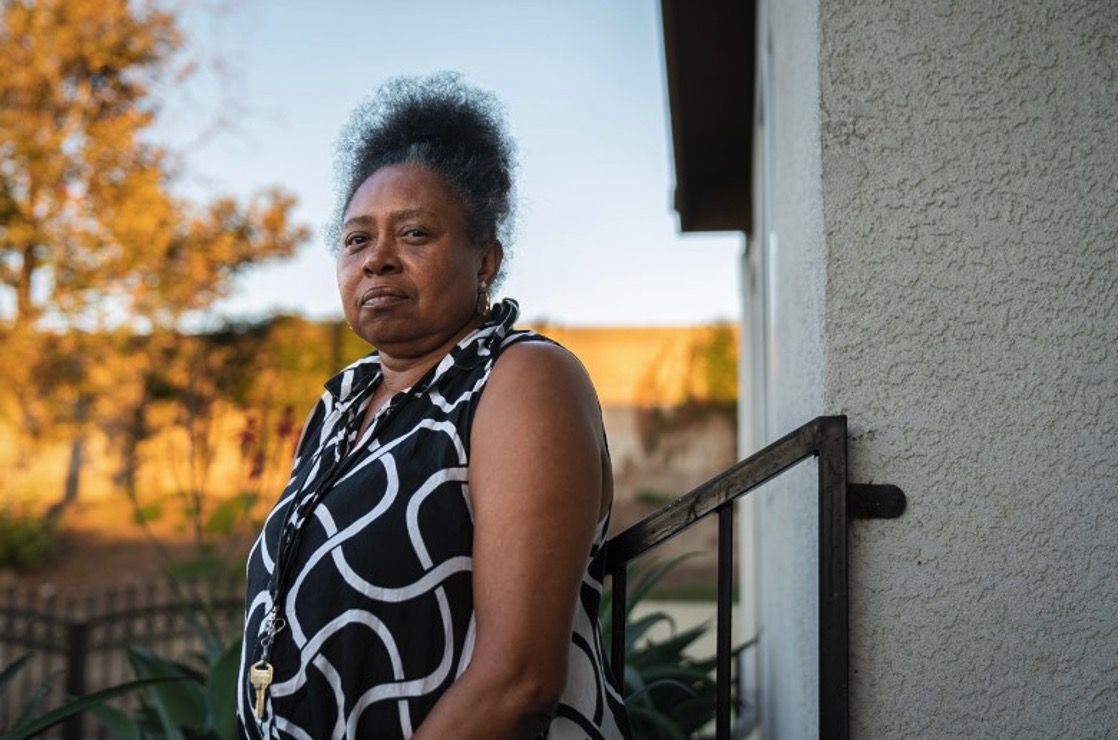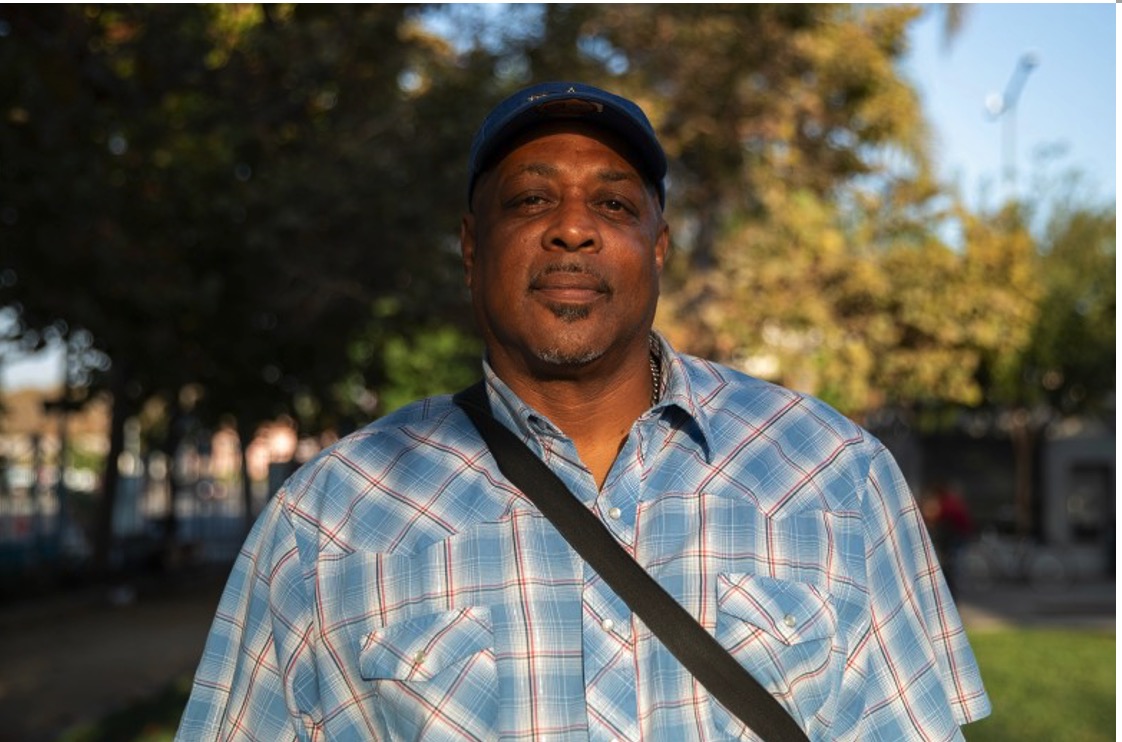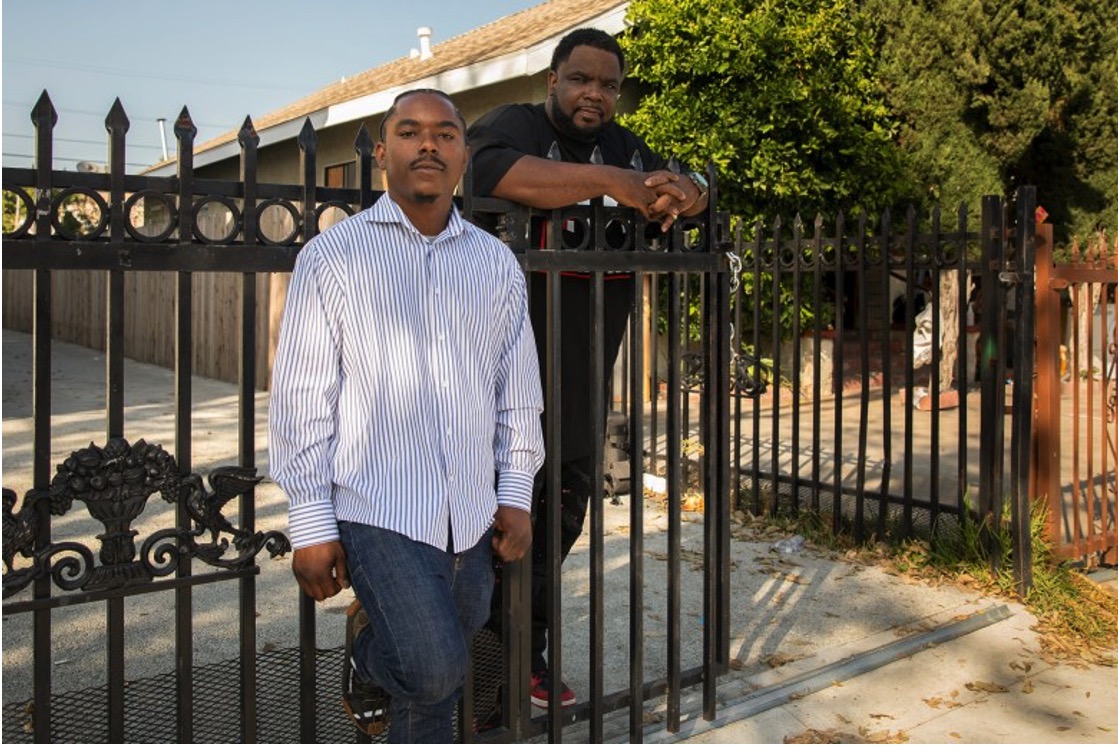Comments
HOMELESS AGAIN - Jesus Mares got a lifeline during the COVID-19 pandemic. Thanks to rental support from one of Los Angeles’ leading homelessness agencies, he had a roof over his head.
He had been bouncing between sleeping in his car and hotel rooms. The taxpayer-subsidized room in a South L.A. duplex provided stability until he could get back on his feet, he’d hoped.
It went well for a while, he said. Then Mares quickly noticed things were amiss with the nonprofit, known as HOPICS. He went through several case managers who Mares said didn’t come to see him.
Then came the eviction notice. HOPICS, which has received about $140 million in Los Angeles city, county, state and federal funding over the last three years for a program known as rapid re-housing, was months behind on paying his rent, according to Mares and his former landlord.
“They basically told us to get out of the building and they locked the building up,” Mares said.
All together 306 people lost taxpayer-funded homes in South Los Angeles as a result of HOPICS’ failure to pay rent on time, the nonprofit said. While more than half were then placed in permanent housing or sent to temporary sites, HOPICS and Los Angeles housing authorities did not say what happened to 119 people.
A CalMatters review of the program, based on hundreds of pages of documents and dozens of interviews, shows that the prominent Los Angeles nonprofit repeatedly ignored explicit eviction warnings from some landlords, did little to vet the middlemen it entrusted to execute the program, and took on far more clients than its case managers could serve.
CalMatters interviewed three participants who landlords said were evicted from HOPICS-funded houses, and they reported ending up back on the streets or living in their cars.

Brenda Wyatt outside of her temporary housing location in Los Angeles on Oct. 4, 2023. Photo by Julie A. Hotz for CalMatters
The eviction mess underscores weaknesses in California’s strategy for addressing its biggest crisis, homelessness. Gov. Gavin Newsom’s administration has allocated more than $20 billion to fight homelessness, but the state’s homeless population surpassed 170,000 people in 2022. Like HOPICS, many government-funded services provide only temporary housing, depend on too few case workers and must compete for units in an already-tight rental market.
Leaders of the nonprofit, whose formal name is Homeless Outreach Program Integrated Care System, say they were overwhelmed by the sudden influx of emergency COVID money during the pandemic to run what’s known as rapid re-housing, a popular local rental assistance program.
To execute the program, HOPICS used middlemen – many of which were newly created nonprofits – to rent out rooms to the unhoused. However, HOPICS’ leaders often didn’t pay those brokers on time, they say, because they needed to review and approve rent bills sent by the very landlords they had chosen to work with. Some of the invoices, they say, had questionable charges.
“We didn’t have the habit of Google searching everybody’s names, and probably that’s a simple fix,” said HOPICS deputy director and former U.S. Rep. Katie Hill. “This is a lot of money that has gone towards a program that has shown that it can house a lot of people. It’s not perfect in any way, shape, or form, and it’s evolving, and we’re learning as we go.”
The federal government sent $100 million in emergency aid to Los Angeles County to address the homelessness crisis during the pandemic, along with another $220 million to six cities in the region including L.A. The Los Angeles Homeless Services Authority then turned to organizations like HOPICS, which is a division of a larger LA nonprofit, Special Service for Groups, to carry out the programs. Between 2019 and 2023, HOPICS placed 3,100 homeless people into permanent housing through rapid rehousing programs, according to the nonprofit.
Annual revenues at Special Service for Groups surged from $84 million in 2018before the pandemic to $149.1 million in 2022. It also gets rapid re-housing funding from Measure H, the 2017 Los Angeles County sales tax and a mix of federal, state and city funds.
While the rush of COVID funding has ended, HOPICS continues to deal with the fallout of the evictions. It still hasn’t paid all of the rent the landlords claim they are owed, it acknowledges. And, separately, three Los Angeles motels sued HOPICS and its parent late last year, alleging it stopped paying rent for clients who were living at the motels. The nonprofit settled the case early this year, though the terms weren’t disclosed.
“We didn’t have the habit of Google searching everybody’s names, and probably that’s a simple fix.”
Katie Hill, HOPICS deputy director none
HOPICS Director Veronica Lewis said her organization can be late with payments because of its efforts to verify that its clients are actually living in the units.
“The notion that we just don’t pay, it’s just absurd,” she said. “We want to be good stewards of public funds.”
CalMatters sent the Los Angeles homeless authority questions about how it funds and oversees HOPICS. The homeless services agency’s spokesperson issued a statement that didn’t answer several questions, including how many clients got into rapid rehousing programs as a result of pandemic funding and how many have returned to homelessness after leaving rapid rehousing programs. The agency also did not comment on whether it’s a common practice for homeless services nonprofits to pay rent late.
The authority’s “role is to ensure service providers receive the funds necessary to bring our unhoused neighbors home … ensure the program is performing efficiently, and work with the provider to identify any performance concerns,” the spokesperson said.
“It’s about time somebody stepped up and exposed what HOPICS is doing,” said Demario Swait, a 59-year-old who was evicted. The nonprofit gets a grant “to make sure that people are housed, and people are not being housed. And I’m one of them.”
Swait and Mares said they are still trying to pick up the pieces from the HOPICS evictions. Swait is now in temporary housing with a different agency, looking for permanent housing, he said.

Demario Swait at Leimert Park in Los Angeles on Sept. 28, 2023. Photo by Adriana Heldiz, CalMatters
Mares packed his things and went back to living in his car, he said. “Right now, I’m at my family’s house trying to get it together, trying to find a new spot.”
Why HOPICS turned to middlemen
A Vietnam veteran who had slept on Skid Row founded HOPICS in the 1980s as a one-man operation working to find housing and services for homeless people.
Today it’s one of the county’s largest homeless services organizations with a contract from the L.A. Homeless Services Authority to coordinate shelter placements and other services in South L.A. To lead the organization, Lewis was paid $261,000 last year, according to the organization’s tax records. She also sits on the state council on homelessness, which Gov. Newsom has charged with developing policies to prevent and end homelessness in California.
HOPICS is supposed to help unhoused people find a place to live, pay a portion of the rent for up to two years and provide a wide range of social services, like employment training and assistance applying for public benefits, according to its contract with Los Angeles County.
Ideally, clients gradually contribute more toward rent until they’re able to stay housed on their own, according to the Los Angeles County Homeless Services Authority.
Landlords are often reluctant to rent their properties to people receiving government rental assistance, whether due to bias or an aversion to red tape.
Property owners who wanted to help house the homeless “don’t necessarily want to be landlords to our population,” Lewis said, and many didn’t want to handle multiple leases for clients sharing one house.
So, instead, HOPICS turned to middlemen. These brokers would rent properties and then sublease rooms in those properties to participants.

Housing 1BY1 Co-Founders Dejon Dixon and Norris Jones in Los Angeles on Sept. 28, 2023. Dixon and Jones say a Los Angeles-based nonprofit owes them hundreds of thousands of dollars in unpaid rent for formerly homeless people. Photo by Adriana Heldiz, CalMatters
CalMatters interviewed five brokers who got into business with HOPICS by renting homes from a large property management group called Ocean Properties, Inc. Ocean Properties describes itself as a development company that flips “small inadequate homes” into larger duplexes. It sells the multi-unit houses to investors and often remains as property manager, renting out more than 2,000 affordable housing units across South L.A.
HOPICS does not lease houses from Ocean Properties directly.
Instead, it goes through people like Norris Jones. He created the nonprofit Housing 1By1 in August 2020, to help with Los Angeles’ housing and homelessness crisis, he said. A month later he welcomed his first HOPICS tenant. Jones and his partner, Dejon Dixon, sublet more than a dozen units, housing more than 80 people for about $950 a month for a private room. They charged $2,800 as a security deposit, according to several signed lease agreements.
Jones and three other brokers said HOPICS would go months without paying rent, causing them to fall behind on paying the property owners. As a result, he says he owes Ocean Properties more than $200,000 in rent and fees. He said he doesn’t understand how a company getting paid by the government “got us in a position where we can’t pay the rent for the people they house in our homes.”
HOPICS officials say Jones has overstated how much it owes him and, in some cases, said he’s submitted invoices far too late to get reimbursed. Still, in a February email to Jones, HOPICS acknowledged owing him $135,000 for 2022 and “upwards of $90k” for 2023.
Now, Jones said HOPICS has paid him some of the unpaid rent. He’s in talks to settle with the agency over the rest of the money he says he’s owed.
“I spent all my money to do this,” Jones said.
In the rush of new funding, HOPICS acknowledged it went into business with some brokers without doing so much as a Google search. For instance, the agency leased 24 locations from Donye Mitchell of LA Supportive Housing. CalMatters found that Mitchell left federal prison in 2014 after serving a sentence for defrauding California’s Employment Development Department.
A property owner in June filed a lawsuit against Mitchell and his business partner in Los Angeles Superior Court, alleging they owe more than $77,000 in back rent for a site his nonprofit used to house homeless people, court records show. Neither party has responded to the suit.
One of several properties managed by Norris Jones and Dejon Dixon, co-founders of Housing 1BY1, in Los Angeles on Sept. 28, 2023. Photo by Adriana Heldiz, CalMatters
Mitchell did not respond to voice messages left with his business partner or emails from CalMatters for this story.
HOPICS officials said some landlords shuffled residents around the units against program rules, and failed to tell the agency about impending evictions until the last minute.
Herbert Hatanaka, executive director of Special Service for Groups, Inc., is personally investigating some of the claims from the brokers.
“There’s missing information,” he said. “We have evidence, for example, clear evidence that there were individuals that were not living in some of those facilities for the time that (the landlords are) billing us for. ”
Overwhelmed L.A. homeless caseworkers
Vetting and paying rent invoices wasn’t the only holdup for HOPICS clients. A persistent shortage of caseworkers contributed as well, former employees told CalMatters.
To have rent paid, rapid rehousing clients must meet with their case managers at least once a month. HOPICS tenants, landlords and former employees told CalMatters that just didn’t happen.
One employee said the agency was badly understaffed because of high turnover and unable to keep up with the number of tenants it was supposed to serve. Los Angeles County requires each case manager to work with up to 25 clients.
“When I signed my acceptance letter, it was for 20 clients, and within 30 days, I had 60,” said Neal Glasgow, a former caseworker for HOPICS who said he left in 2022 after about a year. “I was playing catch-up every month.”
The caseworkers verify that tenants are still living in the units, set tenants’ rent contributions and connect tenants with services.
Glasgow said landlords called him so often about unpaid invoices that some of them became his friends. HOPICS’ leaders acknowledged they didn’t meet the caseworker ratio, citing understaffing in the social services industry.
Several former tenants said they went months without contact from a caseworker, leaving them feeling stranded in temporary placements. Brokers who visited the homes also said their tenants didn’t receive visits from case workers and complained that instead of getting help to become financially stable or get treatment, the clients languished in the houses, sometimes using drugs and having mental breakdowns.
“You put them in a room that they can’t afford and after the program, they’re gonna end up back homeless, and that’s a lot of money wasted.”
--Neal Glasgow, former caseworker for HOPICSnone
In Los Angeles Superior Court claims, three tenants have said they’d seen 15 or 20 different caseworkers in the two years they were allotted in the rapid rehousing program and still hadn’t gotten permanent housing. A judge ruled in May and June that the agency did not owe them any money for emotional distress and dismissed the case.
The current rapid rehousing system of cost-sharing rent for a couple of years doesn’t make sense to some of the people who once ran it.
“It’s setting (the unhoused) up for failure,” Glasgow said. “You put them in a room that they can’t afford and after the program, they’re gonna end up back homeless, and that’s a lot of money wasted.”
HOPICS officials say they now lease some houses directly from property owners. That practice, known as master-leasing, is a strategy agencies including the L.A. Homeless Services Agency, are increasingly considering.
“It’s basically eliminating that middleman that has too much opportunity for problems,” said Hill, the HOPICS deputy director.
An eviction letter posted in one of the residences where Vincent Osby housed formerly homeless people in Los Angeles on Sept. 28, 2023. Photo by Adriana Heldiz, CalMatters
But they also still house clients in units run by brokers. The nonprofit’s officials said they’re doing more to vet landlords before placing clients in their units, including requiring all future and current landlords to sign stricter, clearer program requirements and asking for references.
“We’re asking more questions now,” Lewis said.
Brenda Wyatt, 58, was kicked out of her room on Sept. 4, she said. Her landlord, Vincent Osby, hadn’t been paying the property owner. He confirmed he couldn’t keep up with the rent but declined further comment.
Osby, who played two seasons of professional football for the San Diego Chargers in the 1980s, leased more than a dozen units to HOPICS clients, HOPICS officials said.
The landlord moved Wyatt to another shared house after he fell behind on rent. She said it was unclear whether HOPICS or Osby was at fault for the late rent payments.
“I don’t know what the hell is going on, excuse my French,” Wyatt said. “That leaves us in limbo. We don’t know what to do. We worry about getting kicked back out on the streets.”
(Byrhonda Lyons is a national award-winning investigative reporter for CalMatters. She writes and produces compelling stories about California’s court and criminal system. Byrhonda’s work aims to hold politicians accountable and educate Californians about the ins and outs of their state government.)
(Jeanne Kuang returned home to California to cover the state's economic divide for CalMatters. She previously covered Missouri government and politics for The Kansas City Star, local and state government for The News Journal in Delaware, and criminal justice issues in Illinois. She is a graduate of Northwestern University’s Medill School of Journalism.)
(This article was first featured in CalMatters.org.)






